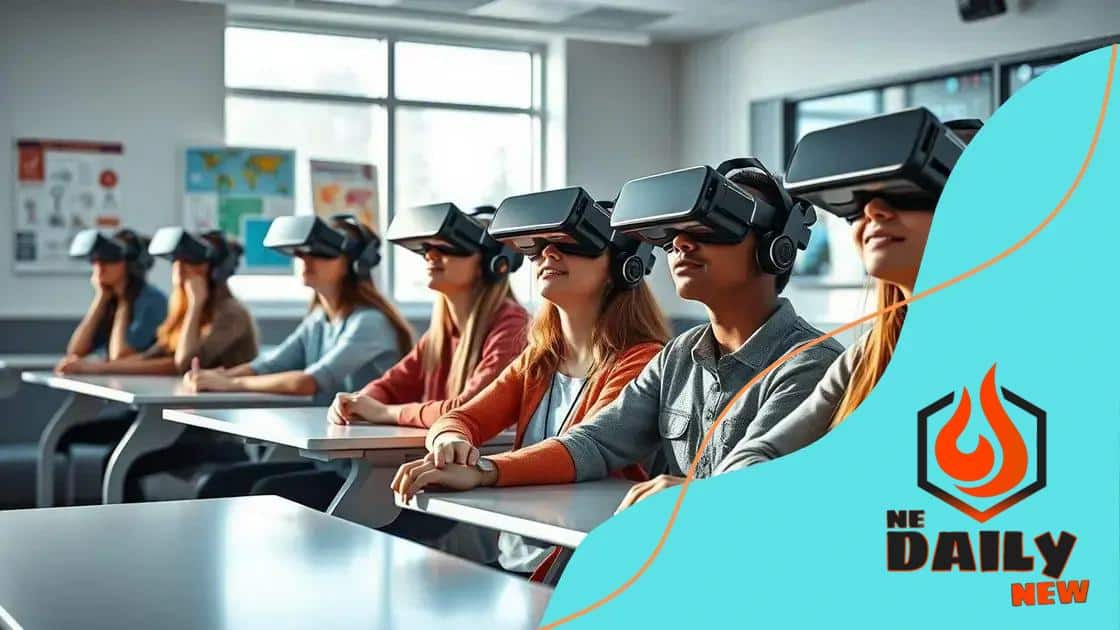The future of education with fully immersive virtual environments

The future of education with fully immersive virtual environments enhances learning by providing engaging, interactive experiences, but faces challenges like accessibility, teacher training, and maintaining student engagement.
The future of education with fully immersive virtual environments is here, transforming how we learn. Imagine stepping inside a science lab or exploring the depths of the ocean—all from your classroom. This article dives into the ways these technologies enhance learning experiences.
Understanding immersive virtual environments
Understanding immersive virtual environments is vital for grasping how technology can change education. These environments allow students to experience learning in a more interactive way, beyond traditional methods. In a virtual space, learners can be transported to historical events, outer space, or even microscopic worlds.
One way to think about this is through the importance of engagement. When students can visualize concepts and actively participate, their retention of information improves. This method not only makes learning fun, but it also promotes deeper understanding.
Key Features of Immersive Environments
Immersive virtual environments offer several key features that enhance educational experiences:
- Interaction: Learners can engage directly with the content.
- Realism: Simulations replicate real-life scenarios, increasing relevance.
- Collaboration: Students can work together in virtual spaces, promoting teamwork.
- Accessibility: Virtual environments can be accessed from anywhere, enabling personalized learning.
By leveraging these aspects, educational institutions can create unique opportunities for students to explore and learn. Imagine studying marine biology by exploring a coral reef in 360 degrees. This kind of experience not only captivates students’ interest but also facilitates a comprehensive learning process.
Furthermore, educators can use immersive virtual environments to tailor lessons to individual learning paces. This adaptability ensures that every student has the opportunity to understand the material fully, regardless of their starting point.
Examples of Immersive Environments
Examples of immersive environments are now being integrated into various educational settings:
- Virtual reality science labs for hands-on experiments.
- Historical simulations allowing students to experience past events.
- Geographical explorations of different parts of the world.
These platforms help make abstract concepts tangible and relatable. The immersive experience also can reduce barriers for those who may struggle with conventional learning methods.
As educators begin to see the potential of these innovative tools, the future of learning looks brighter. Immersive virtual environments are set to revolutionize the way knowledge is absorbed, understood, and applied in the real world.
Benefits of immersive learning experiences
Benefits of immersive learning experiences are profound and can transform how students engage with educational material. These experiences allow learners to step into a world where they can actively participate and explore, rather than just observe. This active involvement can lead to better understanding and retention of knowledge.
One of the most significant advantages is enhanced engagement. When students are fully immersed in their learning environment, they are more likely to focus and participate. Traditional lectures can sometimes lead to disengagement. However, with immersive experiences, such as virtual reality scenarios, students are compelled to interact with the content.
Key Benefits of Immersive Learning
Here are some key benefits that make immersive learning effective:
- Increased Retention: Studies show that experiential learning improves information retention compared to conventional methods.
- Real-World Application: Students can practice skills in a safe environment, preparing them for real-life scenarios.
- Boosted Creativity: Immersive environments encourage creative thinking, allowing students to explore multiple solutions.
- Tailored Learning Experiences: These environments can cater to different learning styles, enhancing overall effectiveness.
Moreover, immersive learning experiences often foster collaboration among students. Working together in a virtual class can enhance communication and teamwork skills. This collaborative spirit can lead to deeper discussions and expand perspectives.
As students navigate these environments, they can face challenges and solve problems in real-time. This aspect of learning not only builds confidence but also prepares them for future challenges. In this way, immersive experiences are not just about learning facts but about developing critical thinking skills.
Improved Motivation and Attitude
Another benefit of immersive learning is the increase in motivation among students. Engaging in exciting and interactive lessons can spark a genuine interest in the subject matter. Students are often motivated to learn more when they see the practical application of their studies.
Additionally, because immersive learning can provide immediate feedback, students can track their progress and stay informed about their performance. This instant feedback loop helps them stay engaged and invested in their education.
Overall, the benefits of immersive learning experiences are significant. With ongoing advancements in technology, the potential for enhancing educational experiences continues to grow.
How technology is shaping educational landscapes

How technology is shaping educational landscapes is a topic that showcases the rapid changes in teaching and learning. Technology has become an integral part of education, influencing how students and teachers interact with content and with each other. With tools like virtual reality and online platforms, education is more accessible than ever.
One major change is the way information is delivered. Traditional classrooms are evolving into interactive learning environments. This shift allows students to access resources online, participate in discussions, and collaborate on projects in real time, no matter where they are. Schools are increasingly adopting digital resources, which provide a wealth of knowledge at students’ fingertips.
The Role of Technology in Personalized Learning
Technology also plays a crucial role in personalized learning. Here are some significant ways it impacts education:
- Adaptive Learning Platforms: These platforms adjust content to fit individual learning speeds and styles.
- Data Analysis: Educators can analyze student performance data to tailor lessons accordingly.
- Engagement Tools: Gamification and interactive activities keep students motivated and focused.
- Accessibility: Students with disabilities benefit from a range of assistive technologies that support their learning needs.
Through these methods, technology addresses the unique learning requirements of each student. This approach can lead to improved outcomes as students receive the support they need to succeed.
Another change technology brings is the rise of online education. Online learning environments offer flexibility that traditional classrooms cannot. Students can learn at their own pace, revisiting materials as needed. This flexibility makes education more achievable for many, including those balancing other responsibilities.
Collaboration and Global Learning
Technology also enables collaboration across geographical boundaries. Students can work together on projects with peers from different countries, gaining insights into diverse perspectives. This form of collaboration prepares students for a globalized world, enhancing their teamwork and communication skills.
Moreover, online forums and discussion boards foster a sense of community among learners. These interactions can make learning more enriching and enjoyable, enhancing the overall educational experience.
As technology continues to advance, so will its impact on education. The landscape will keep transforming, providing exciting opportunities for innovative teaching methods that engage and inspire learners.
Real-world applications of virtual education
Real-world applications of virtual education are transforming how learning is delivered across various fields. Virtual education is not just a trend; it offers practical solutions that enhance the learning experience. With technology, students can now engage with content in ways that were once unimaginable.
One significant application is in higher education. Many universities and colleges are adopting online courses to reach a wider audience. This approach allows students from different backgrounds to access quality education without relocating. These online programs often include interactive elements like discussion forums and multimedia presentations.
Corporate Training and Skill Development
Another key area where virtual education shines is in corporate training. Many organizations are using virtual platforms to train employees:
- Cost-effectiveness: Virtual training reduces travel expenses and allows for flexible scheduling.
- Scalability: Companies can train a large number of employees simultaneously, regardless of their location.
- Interactive Learning: Virtual simulations and scenarios help improve practical skills.
- Consistent Training Quality: All employees receive the same training materials and instructions.
These benefits make virtual education an attractive option for companies looking to enhance workforce skills. Additionally, employees can revisit materials as needed, helping them retain information better.
Moreover, schools are utilizing virtual education for remote learning. During challenging times, such as the COVID-19 pandemic, educators swiftly adapted to online platforms to continue teaching. This change highlighted the flexibility of virtual education and its importance in maintaining academic progress.
Immersive Learning Experiences
The incorporation of virtual reality (VR) and augmented reality (AR) technologies in education is another exciting development. Schools are beginning to use these tools to create immersive learning experiences:
- Virtual Field Trips: Students can explore historical sites or natural wonders without leaving the classroom.
- Hands-on Experiences: Science and engineering students can conduct virtual experiments in safe, controlled environments.
- Real-Time Collaboration: Learners can work together in virtual spaces, regardless of their physical locations.
These applications illustrate that virtual education is not limited to traditional subjects; it expands learning opportunities across various disciplines. Students can engage deeply with the material, enhancing retention and understanding.
As virtual education continues to evolve, its real-world applications will likely grow, making learning more accessible and engaging for everyone.
Challenges in adopting virtual environments in education
Challenges in adopting virtual environments in education can create significant hurdles for institutions and learners. While the benefits are clear, implementing technology in educational settings is not always straightforward. It requires careful planning and consideration of various factors.
One major challenge is the accessibility of technology. Not all students have equal access to the necessary devices and reliable internet connections. This digital divide can lead to disparities in learning opportunities. Schools must find solutions to ensure that every student has the tools they need to succeed.
Training and Support
Additionally, teacher training is crucial for the effective use of virtual environments. Many educators may not feel comfortable using new technologies. Therefore, ongoing professional development is essential to help teachers learn how to utilize digital tools effectively.
- Effective Training Programs: Institutions need to develop training programs tailored to educators’ needs.
- Peer Support: Encouraging collaboration among teachers can enhance learning and sharing of best practices.
- Ongoing Resources: Providing resources for teachers to refer to can help sustain their learning.
Furthermore, curriculum adaptation is another challenge. Virtual environments require a rethinking of traditional teaching methods. Educators must adapt their lesson plans to fit interactive learning experiences, which can be time-consuming and complex.
Another significant hurdle is student engagement. While virtual environments can be engaging, some learners may struggle with self-motivation in online settings. It is essential for educators to implement strategies that keep students engaged, such as interactive content and collaborative projects.
Technical Issues and Support
Technical difficulties are also a common barrier. Students and teachers may encounter glitches, crashes, or connectivity issues that disrupt learning. Institutions must invest in strong IT support to address these problems promptly.
- Reliable IT Support: Access to help when technical issues arise is vital for both students and educators.
- Proactive Monitoring: Regularly checking systems can prevent problems before they affect learning.
- Feedback Mechanisms: Students should have a way to report issues easily.
Lastly, maintaining a balance between virtual and face-to-face interactions is important. While virtual environments offer unique opportunities, they can lack the personal connection found in physical classrooms. Schools need to find ways to blend both approaches effectively, ensuring students receive a holistic education.
FAQ – Frequently Asked Questions about Virtual Education
What are the main challenges in adopting virtual environments?
The main challenges include accessibility issues, teacher training needs, curriculum adaptations, student engagement, and technical support.
How can schools ensure all students have access to virtual education?
Schools can provide devices and internet access through community programs or partnerships to help bridge the digital divide.
Why is teacher training important for virtual education?
Proper teacher training helps educators feel confident in using technology, which enhances the overall learning experience for students.
What strategies can keep students engaged in virtual learning?
Incorporating interactive content, collaborative projects, and regular feedback can help maintain high levels of student engagement.





